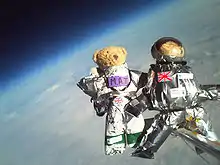Teddy bear parachuting
Teddy bear parachuting, sometimes referred to as parafauna, is a game in which teddy bears equipped with parachutes are dropped from a height. It is increasing in popularity as a charity fundraiser, and competitions based on the descent time are also common.
A typical teddy bear parachute may be made from an old umbrella canopy or other lightweight material. A simple hemispherical pattern of multiple tapered gores may be sewn from ripstop nylon kite or sail fabric.[1] Many bears are dressed and fully equipped with parachute packs, helmets and goggles.

While jumps are commonly from high buildings such as church towers[3][4] and castles, some are more ambitious, with at least one regular event including parachuting from a light aircraft.[5]
The first bears to do a jump from a light aircraft are still around, and go under the name of the "Ted Devils". A unique item that takes place at airshows (including those at fetes and private functions) devised and run by a well known UK display pilot and aircraft.[6] Additionally, these bears are fund raisers that support the local community, by letting the local community take part in the event before the day.[7]
Parachuting bears are also lifted by kite and released with a dropper mechanism. This method is cheap and highly portable.[8] Kites such as parafoils or large deltas are particularly suitable for this.[1] As many kite fliers also make their own kites, the parachutes are usually self-manufactured too. Most bears must be lifted aloft along with the kite. Some small bears may be transported along the line of an already flying kite by a messenger, a small carriage with sails.[9] When the messenger reaches the top of the kite line, the bear is released automatically.[1] This is a much simpler method for repeated drops or charity events.
The parachuting of teddy bears was used as a political statement when several hundred of the stuffed toys bearing protest slogans were dropped over the Belarus city of Minsk on 4 July 2012.[10]
See also
References
- Moulton, Ron; Lloyd, Pat (1998). Kites: A Practical Handbook (3rd ed.). ISBN 1-85486-143-3.
- "Cambridge University Spaceflight (Society)" (PDF). Retrieved 4 December 2011.
- "Teddy Bears Go Parachuting". Archived from the original on October 3, 2006.
- "St. Nicolas Church Bells | North Stoneham & Bassett Parish | Southampton". Hants.gov.uk. Retrieved 2011-12-04.
- "BBC Cambridgeshire". Bbc.co.uk. Retrieved 2011-12-04.
- Nigel Willson. "UK Aerobatic display and Ted Devils act". yakdisplay.com. Retrieved 2011-12-04.
- Willson, Nigel. "The Ted Devils". Yakdisplay.com. Retrieved 2011-12-04.
- "Parafauna UK". Parafauna.co.uk. Retrieved 2011-12-04.
- "Messengers, Droppers and Releases". parafauna.co.uk.
- Carlstrom, Johan (3 August 2012). "Sweden in Diplomatic Row With Belarus After Teddy Bear Drop". Bloomberg News. Bloomberg. Retrieved 13 August 2012.
